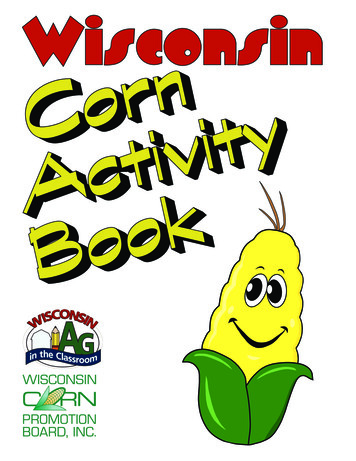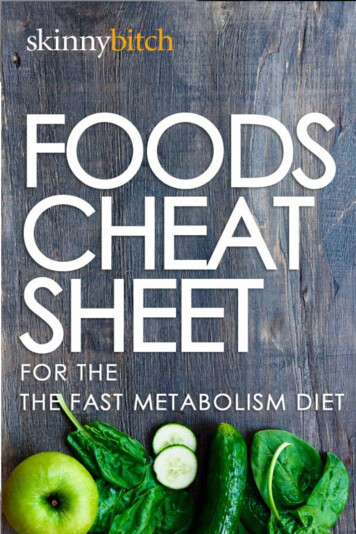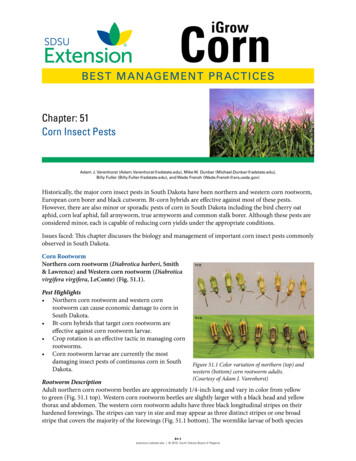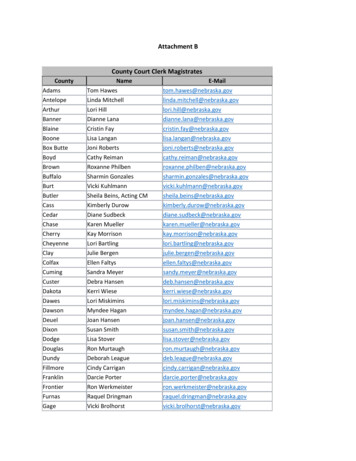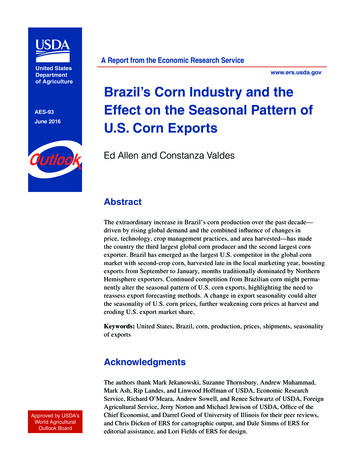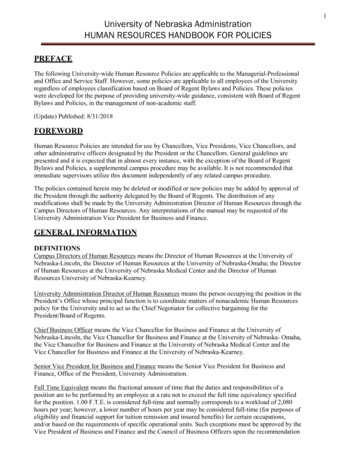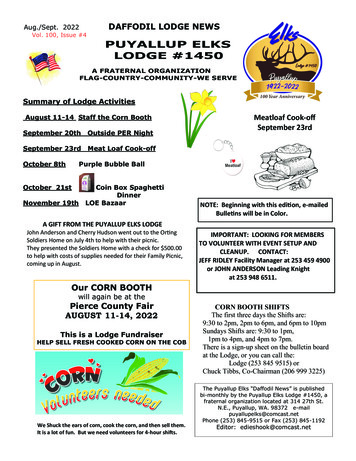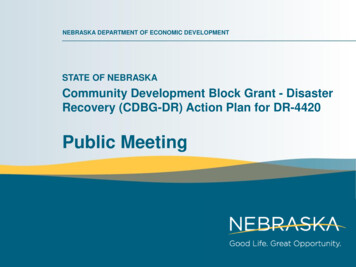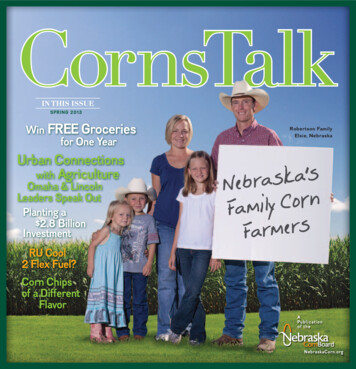
Transcription
CornsTalkIn This IssueSPRING 2013Win FREE Groceriesfor One YearRobertson FamilyElsie, NebraskaUrban Connectionswith AgricultureOmaha & LincolnLeaders Speak OutPlanting a 2.8 BillionInvestmentRU Cool2 Flex Fuel?Corn Chipsof a DifferentFlavorAPublicationof theNebraskaCorn.orgCORNSTALK 1
Corn farming in Nebraska results directly andindirectly in 63,900 jobs across the state,plus 10,900 jobs in the ethanol sector.Nebraska corn farmers willinvest an estimated 2.8 billionthis spring just to get the corncrop planted – and that doesn’teven include the expense ofequipment, land costs andlabor. What becomes of thatinvestment come harvest?What does a 2.8 billion investment become?As Tim Scheer navigates his combinethrough cornfields near St. Paul, Neb.,every fall, the millions of corn kernels pilinginto waiting semis are really little economicpowerhouses upon which Nebraska thrives.“Those kernels are pretty small on their own,but together they snowball into quite aneconomic driver,” Scheer said.Once corn leaves the field, everywhere it’sused adds value. For example, an ethanolplant takes that corn and makes ethanol anddistillers grains, a livestock feed. Fuel blendersadd that ethanol to gasoline, while livestockproducers feed distillers grains and turn it intobeef, pork, poultry and dairy products.“Corn is not only a predominant crop but apredominant enterprise. It ripples through theeconomy a long way. The carry through of cornto processing and feed is just phenomenal,”said Dr. Bruce Johnson, an economist with theUniversity of Nebraska–Lincoln.2 SPRING 2013In an analysis, Johnson and his colleaguesestimated that corn production and its ripplejust through the ethanol industry has a valueadded impact of 6.6 billion on Nebraska’sgross state product (GSP is comparable to thegross domestic product on a national level).That figure is just the portion attributable tocorn and ethanol – livestock and poultry eachhave their own sizable impact, as well, and relyheavily on corn and distillers grains as an input.That figure also doesn’t include all the productschanging hands just to grow a crop. Forexample, the 2.8 billion, roughly 270 peracre, Nebraska farmers invest to get the cropplanted includes only seed, fertilizer and otherinputs necessary to get the crop off to a goodstart. Those dollars go to cooperatives, seeddealers and others who sell those inputs andemploy thousands of Nebraskans, convertingthat 2.8 billion investment into a 7.0 billionripple through the state’s economy.Shannon Landauer, executive director of theBoone County Development Agency, has seenthat impact first hand.“Between late 2006 and the third quarterof 2011 we saw 170 new jobs and more than 400 million invested in Boone County,” shesaid. “Having such a strong ag economyallowed us to weather the economic downturnpretty well. In fact, our unemployment rate isbelow 3 percent locally. Corn, livestock andethanol all come together well for us.”The analysis by Johnson and his colleaguespegged direct and indirect jobs for cornproduction at 63,900 across the state, plus anadditional 10,900 jobs for ethanol. The laborand proprietor income generated from thesejobs comes to nearly 5.3 billion – and that’snot even counting the role of corn workingthrough the livestock sector.“Those are big numbers, important numbersfor Nebraska,” said Scheer. “The investmentcorn farmers make every spring is thefoundation for the state’s economy, thousandsof jobs and a lot more. It’s pretty incrediblewhen you think about it.”
Nebraska’sranking incattle on feed2362Nebraska’sranking inannual cornproductionNebraska’sranking inethanolproductioncapacityMillions oftons of livestockfeed produced byNebraska’sethanolplantsannuallyRU Cool 2FlexFuel?One in ten Nebraskans is driving aFlex Fuel Vehicle (FFV). Are you one of them?H2Oh?A Flex Fuel Vehicle (FFV) provides the ultimate in consumer fuel choice,allowing you to choose any blend from ordinary unleaded gasoline upto 85% ethanol (E85)—and everything in between including E10, E15,E30, etc. You can fill up with one fuel blend one time and with anotherthe next—at any time and in any amount. You can choose your fuelblend based on availability, cost, preference and performance.How to tell if you’re driving an FFV.Nebraska corn farmers are using innovativetechnology to better manage irrigation water.Evapotranspiration (ET) gauges, like the one shown here, let farmers knowhow much water corn plants have taken up from the soil and evaporated intothe air. Additional sensors keep track of how much water is available in thesoil. Combined, these two technologies give an accurate picture of water use,when farmers need to irrigate and how much.Research using these tools has shown farmers how to reduce water use by upto 25% while still achieving good yields—and saving energy costs. “When it’shot and sunny, you want to believe it’s drier than it really is and that the cropis using more water,” says farmer Mark Jagels of Davenport. “We’ve learnedthat isn’t always the case—and we can wait a few more days before irrigating.”FFVs look like any other vehicle of the same make and model.To know if you’re driving an FFV, look for: A Flex Fuel badge or insignia on your vehicleA sticker inside your fuel doorA message on your gas cap (some FFVs have bright yellow gas caps)Information in your owner’s manualOr make note of your Vehicle Identification Number (VIN), make,model and year of your vehicle and visit one of these websites: e85prices.com afdc.energy.gov/afdc/vehicles/light?fuel type code E85 GSLThere are also apps available for your smartphone.CORNSTALK 3
Omaha and Lincoln leaders conneNebraska’s urbanThe Nebraska Corn Boardrecently invited business andeducational leaders from Omahaand Lincoln to participate in a“virtual roundtable” discussion of theopportunities and challenges facingNebraska agriculture. Additionally,they were asked to discuss theconnection between the successand mission of their “urban based”organizations and the success ofNebraska agriculture as a whole.Responses have been edited forthis publication. To read the fullresponses from all participants, visitNebraskaCorn.org.A sincere thanks to these Nebraskaleaders for sharing their thoughtsand insights.Todd BeckerPresident, CEO & DirectorGreen Plains RenewableEnergy, Inc.OmahaDavid BrachtPartnerStinson Morrison Hecker,LLP & Chairman, AgricultureCouncil of Greater OmahaChamber of CommerceOmahaBob CampbellSenior Vice PresidentFarm Credit Servicesof AmericaLincolnJohn CampbellSenior Vice PresidentAGPOmahaHow does Nebraska’s strength in corn, livestock and ethanol influence your business or organization?How does your location in Nebraska provide a competitive advantage or growth opportunities for you?HAMMES: Transportation is a key part of thefood supply chain and rail is the safest, most fuelefficient mode. It all starts on the farm, but UnionPacific is part of delivering it to the table.BECKER: Nebraska’s leadership in corn and cattleproduction is a good fit for Green Plains. Thelocation of our Nebraska plants in the westerncorn belt makes us competitive in ethanol marketsin the southwest and western U.S.GREEN: Few other states “have it all” when itcomes to agriculture. Nebraska is truly a naturalliving laboratory with more than 45 million acresof farmland, the world’s largest aquifer and oversix million cattle. Being located in Nebraska, theglobal epicenter of food production, allows usthe unique opportunity to play a leading role infeeding the world’s people sustainably.4 SPRING 2013BRACHT: As a lawyer focusing on agriculture—andBOB CAMPBELL: We are a cooperative withDUNCAN: There is no other state better positionedWARNER: More than half the land in Nebraskaan ag lender before that—Nebraska is a near idealplace for me to develop my practice. Nebraska’sdiversification in livestock, grain and renewableenergy provides greater balance and stability asmarkets change and weather events occur.to take advantage of the conversion of globaldemand for food, fuel and water. NebraskaInnovation Campus is launching in the right placeat the right time, no doubt in my mind.KALKOWSKI: Our bank’s footprint closely mirrorsthat of our nation’s food production. The factthat Nebraska is at the heart of both agriculturalproduction and our bank network puts us in agreat place to support opportunities in agriculturefar into the future.the sole purpose of supporting our customerowners in all facets of agriculture. The strengthof agriculture in Nebraska and across the countryis economically vital to our customer-owners andour nation.is owned by non-operating land owners, whoare partners in production and very importantinvestors in agriculture. Most have a ruralheritage and now live in towns and cities withinthe state. Our company works with this group oflandowners.JOHN CAMPBELL: AGP has invested heavily inNebraska due to our position in the growingwestern grain region, rail access to exportmarkets and irrigated crops.
ect the dots betweencenters and Nebraska agriculture.Dan DuncanExecutive DirectorNebraska Innovation CampusLincolnDr. Ronnie GreenVice President, Agricultureand Natural Resourcesand Harlan Vice Chancellor,Institute of Agriculture andNatural ResourcesUniversity of Nebraska–LincolnLincolnPaul HammesVice President, GeneralManager Agricultural ProductsUnion PacificOmahaChris KalkowskiVice PresidentFirst National Bank of OmahaOmahaWhat do Nebraska consumers, especially those in urban areas,need to better understand about Nebraska agriculture?BRACHT: Nebraska’s agriculture industry is thebasis for a significant portion of the economicactivity in the greater Omaha area. Omaha hasseveral national and international companiesdirectly involved in food and agriculture, alongwith many more that support these businessesand other ag-based companies and producersstatewide.KALKOWSKI: It seems to me if one industryprovides one-third of our state’s jobs and is thelargest economic driver, we need to make aconcerted effort to provide our fellow citizenswith a basic understanding of agriculture and itsrole in our lives.JOHN CAMPBELL: The consumer is constantlybeing hit with misinformation about the food theyeat. The food agenda is being formed by peopleand organizations that are well meaning, butmiss the important point. Our most pressing foodproblem is not one kind of food or the other—it’soverconsumption of total calories coupled withlack of exercise.BECKER: Nebraska produces over two billiongallons of ethanol each year, but only uses slightlybetter than half the ethanol it could use in itsown motor fuels. Nebraska exports 97% of theethanol produced in the state. It’s a shame we’renot doing more to consume this high-octane fuelproduced right here.HAMMES: Consumers all across the U.S.benefit from a large, safe, diverse and relativelyinexpensive food supply because we have greatagricultural resources and the ability to supplylarge transportation centers.Jerry WarnerExecutive Vice PresidentChief Management OfficerFarmers NationalOmaha“We are not so much a nationof red versus blue as we are anation of rural versus urban.The urban dwellers of ourcountry need to eat; theywant to know more abouttheir food—and that it is safeand wholesome. Nebraskaagriculture will play a bigrole in feeding the world andeducating our customers.”Chris KalkowskiFirst National Bank of OmahaCORNSTALK 5
“The diversity of Nebraskaagriculture is one of itstremendous strengths. It isalso one of its challenges.”Jerry WarnerFarmers NationalThe number of gallons ofethanol produced for eachgallon of petroleum-based fuelused over the entirecorn-to-ethanolproduction cycleDUNCAN: Agriculture is not just the iconicrural scene many people have in their minds.It’s made up of farmers, millers, processors,researchers, logistics, transportation,engineering, and more. It’s a large sector runby people with excellent skills in businessand environmental stewardship.BECKER: All Nebraskans should trulyunderstand the impact of agriculture on theeconomy of this state. We are a leader andinnovator in food, feed and fuel production—and our economy has recently been strongerthan in other states because of that.WARNER: A vibrant ag economy contributesto strong land values, good rental rates andprofits for land owners, which strengthensthe overall economy of the state. The impacton the economies of Lincoln and Omaha isfar greater than most people realize.GREEN: There has never been a greater needfor what we do to feed, clothe and sustaina healthy and growing world of people andour land and natural resource systems. Wemust continue to elevate our investmentsin agricultural research, education andextension to continue to make innovationscome to life.What should Nebraska do to leverage its strength inagriculture to enhance statewide economic vitality—andposition the state for long-term success in meeting globaldemand for food, feed and fuel?13DUNCAN: Focus and invest where the greatest“Biofuels have propelled a ruralrenaissance in Nebraska andallowed the state to thrive eventhrough a deep and lastingnational recession. It is criticalthat Nebraskans understandtheir connection not only toagriculture, but agriculture’sconnection to biofuels.”John CampbellAGP6 SPRING 2013BOB CAMPBELL: Consumers need to knowthat agricultural producers in Nebraska arecommitted to provide the highest quality andsafest food in the country. Producers needto manage their businesses in a manner thatallows them to deliver on that commitment,while providing a living for their familiesand employees.KALKOWSKI: If we’re concerned about policychance for success lie. We have to defineour identity—what we can do better thananyone else—and then put plans into place tobecome the world leader in that area(s).being created today, imagine what it will belike as we continue to develop young peoplewith little understanding of agriculture.BOB CAMPBELL: Agriculture is the economicproduction industry while neighboring statesgrew. The economic losses to the statewere substantial. If we’re going to take fulladvantage of our crop production capacity,we must also add value through a vibrant andgrowing livestock sector that includes porkand dairy operations.base in Nebraska. We need to make sureour tax and regulatory environment allowsNebraska producers and agribusinesses tobe competitive in a global market.GREEN: Securing a healthy policyenvironment for profitable and sustainableanimal agriculture is of utmost importance.Livestock farms and ranches in Nebraskapossess the capacity to convert a widerange of grasslands and feed sources inthe delivery of nutrient-rich food for humanconsumption. The importance of animalagriculture has never been greater; weneed to innovate the industry under a verydifferent economic scenario.JOHN CAMPBELL: Nebraska lost its porkBRACHT: With its diversity and nationalleadership in several ag sectors, Nebraskacan create some powerful synergies. We’resecond in ethanol production in the U.S., duein great part to our strong cattle industry andirrigated corn production. Ethanol producerscan rely on a consistent supply of corn, evenin drought years. And cattle producers can
rely on the wet distillers grains from ethanolproduction to feed their cattle. We must takeadvantage of other potential synergies ofthis nature.WARNER: We must continue to increaseboth irrigated and dryland corn production inNebraska. We must be more efficient waterusers everywhere, but especially in the morelimited aquifers. If rural and urban interestswork together, we can bring new systemsinto use which will conserve water and makeenough available for everyone.HAMMES: While Nebraska has significantin-state markets for grain and grain products,the long-term demand growth will be alignedwith exports. Nebraska needs to continue toinvest in infrastructure and crop productionpractices to capture and access thesemarkets. Union Pacific alone plans to spend 1 billion in new investment in Nebraska overthe next several years.What concerns you most about the future of agriculture inNebraska? What will it take to address those concerns?BECKER: As corn prices rose this past year,it was clear that the change in the price wasrelated to the unfortunate and uncontrollabledrought, not to the demand for corn from theethanol industry. Still, several requests weresubmitted to the EPA to waive the RenewableFuels Standard. While requested waiverswere eventually denied, this was a wakeupcall for all ag-related businesses to worktogether and understand that we all have aplace in Nebraska agriculture. By increasingthe diversity of markets, we are supportingfarmers—and each other—in good timesand bad.BRACHT: The declining number of youngpeople with direct agriculture experienceposes both a challenge and an opportunity.Agriculture organizations and educationalinstitutions that can foster a similarunderstanding among people with differentbackgrounds will provide individualopportunities and serve the greater goodof the agricultural community.JOHN CAMPBELL: Nebraska’s ace-in-the-holeis our underground water resources. Nobodylikes regulation, but water quantity and qualitywill suffer—perhaps irreversibly—if water isnot responsibly managed by both local waterauthorities and by the State.KALKOWSKI: One of every three Nebraskajobs is derived from agriculture. So, I am veryconcerned that only 50% of our state’s highschools offer agricultural education—and thatonly 13% of Nebraska’s high school studentsare enrolled in an ag education class.GREEN: Attracting and retaining the bestand brightest individuals in agriculture is ofgreatest concern. The competition for talent isfierce. We must find ways to make it possibleand attractive for future generations to beinvolved in all aspects of agriculture.BOB CAMPBELL: It’s important to start talkingwith people who don’t have agriculturebackgrounds about the career possibilities.The industry needs people with training inmath, science, computer technology, biology,social sciences and many other skills.DUNCAN: Moving from a reactive to aproactive position on social, production,drought and other issues will be a key foragriculture to evolve to meet ever changingneeds and expectations. Doing so takesconsensus, resources and leadership.1.3Photo courtesy of: University of Nebraska–Lincoln“Providing enough food to feed9 billion-plus people in 2050 isa daunting task. We need to beaggressive in our development ofnew and improved technologiesand management practicesto increase our efficiency,sustainability, and profitabilityof agricultural production—and combine those efforts withenhancements in the foodsupply chain to improve humanhealth and quality of life.”Dr. Ronnie GreenInstitute of Agriculture and Natural Resources,University of Nebraska–LincolnBillions of bushels of corn produced in Nebraska in2012; the 7th largest crop in the state’s history,despite the worst drought in five decadesCORNSTALK 7
Win FREEgroceries for a year!Register at FarmersFeedUS.orgRegister for a chance at one of two grand prizes of 5,000 in“Free Groceries for a Year!” when you take a moment to learn more aboutfood production from some Nebraska farmers, a veterinarian and a grocer.Just visit FarmersFeedUS.org to register. In the process, you’ll get the chance to“meet” a Nebraskan involved in producing safe and nutritious food. You can registerdaily with each of the seven Nebraskans featured through April 8, 2013.Anselmo, Nebraska, corn farmerKyle Cantrell is featured in one of thevideos you can watch and then registerto win a year’s worth of free groceriesat FarmersFeedUS.org.CORNCHIPS?By analyzing a sliver – chip – of a cornseed, plant researchers can discover if it has the right geneticsand yield potential before it ever goes on to the next phase of research.District 1Dave NielsenLincoln, NEDistrict 6DennisGengenbachSmithfield, NEDistrict 2Mark JagelsDavenport, NEDistrict 7David MerrellSt. Edward, NEDistrict 3Curtis FriesenHenderson, NEDistrict 8Jon HolzfasterPaxton, NEDistrict 4Bob DickeyLaurel, NEDistrict 5Tim ScheerSt. Paul, NEAt-largeAlan TiemannSeward, NENebraska Corn Board membersrepresent the eight districtsindicated on the map and areappointed by the Governor.One at-large member is electedby the other Board members.Automated tools remove the chip, which while tiny, is big enough for researchers toanalyze for the right genetic markers. If tests on the chip show it has potential, theseed moves forward and is planted in the next phase of research.Removing a chip does not damage the corn kernel’s ability to grow but it savesconsiderable research time by eliminating seeds from the program without havingto plant, grow and harvest the next generation.With this sort of enhanced molecular breeding, the odds of finding the rightcombination of higher yield genes is one in five, compared with two in onetrillion in conventional breeding!8 SPRING braska Corn Board301 Centennial Mall South, Fourth FloorBox 95107, Lincoln, Nebraska 68509Phone 402/471-2676Toll-Free 800/632-6761
Shannon Landauer, executive director of the Boone County Development Agency, has seen that impact first hand. "Between late 2006 and the third quarter of 2011 we saw 170 new jobs and more than 400 million invested in Boone County," she said. "Having such a strong ag economy allowed us to weather the economic downturn pretty well. In fact, our unemployment rate is below 3 percent locally .
